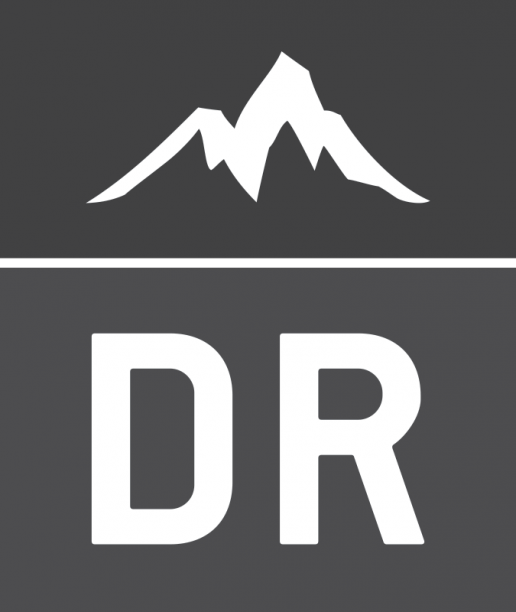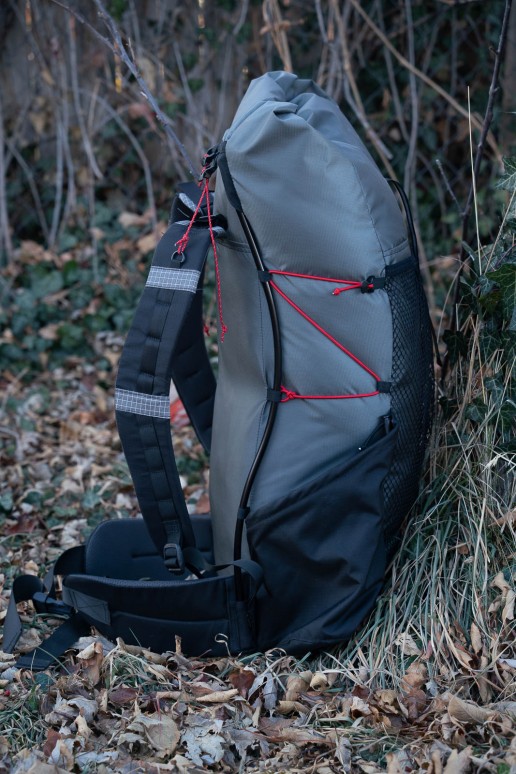A Sub-One Pound Ultralight Framed Backpack
The last decade I’ve had a lot of packs, GoLite, ULA, Gregory and Osprey both for a short stretch, and my current favorites from Hyperlite Mountain Gear. But the one pack I’ve loved and never really found a great replacement for is a ULA CDT I used on the PCT in 2010. It was light, frameless, burly, and just the right volume for quick fair-weather trips in the alpine where a bear can isn’t necessary. It also had a draw cord closure, which after years of roll tops, I kinda missed how convenient they can be. I retired that pack long ago when the mesh pockets were no longer salvageable.
I contemplated just buying a new and improved CDT this year, and possibly adding the minimalist frame set to it, as my body doesn’t seem to agree with frameless designs quite as well as it once did. Then the pandemic hit, and I started sewing. A lot.
Over the course of the last 9 months, I’ve made 8 or 9 backpacks (most of which will never see the light of day for what I consider fatal flaws), a pair of zipper-less tents, a camera bag, lots of smaller bags and bike bags, and even licensed a pattern for production. (More on that later.)
The last project I made in 2020 was an attempt to replace that faithful old CDT, with one big difference – a full inverted “U” frame made from 7075 aluminum.
This is what I came up with.
Overall Weight:
15.8 oz: Includes 2.0 oz 7075 Aluminum Frame
Fabric
Main Pack: Robic 100d Ripstop
Back and Bottom Panel: Robic 210d Ripstop
Pockets: Polyester Utility Mesh
Features
35L capacity in the main pocket (~2000ci)
Inverted U-Frame for lateral and vertical stability
Drawstring Closure
Hipbelt Wings with 1/4 EVA foam
1 1/2 inch webbing on belt
Load lifters
Component Weight
Backpack, Stripped: 13.2 oz
Frame: 2.0oz
Shock Cord: .6 oz
Suspension Design
This was the real design challenge. My goal was obviously to make the lightest frame possible for loads with a total weight of around 25 pounds or less. The simplest and way to accomplish this would be to just add two vertical frame stays on the outside edge of the back panel – somewhat similar to how KS Ultralight does their frame stays. These can be super light, if you use carbon possibly less than an ounce for the pair.
This simple design can work ok on fairly light loads, but it has a couple serious drawbacks I wanted to avoid. First is there is zero lateral rigidity, and second is the straight stays don’t fit the curves of a human lumbar at all. In my case, I’ve tried them on a couple other packs, and they would often hit my shoulder blades at right around the shoulder strap. This isn’t always an issue, especially on packs that tend to barrel when they are stuffed because it pushes the stays away from the back. In general, I’d like to avoid barreling as much as possible and keep the load as close to my body as possible. The frame does help quite a bit in this regard, and the side panels being cut to match the curve of the stays gives it additional shape and structure when fully loaded.
There is, however, one really big advantage to moving the frame to the periphery of the back panel, and that is you don’t need much if any padding to keep the stays from hitting your back if they are curved correctly. With a good curve the frame itself never contacts any part of your body, leaving just a well packed bag for the padding. That’s the single biggest thing you can do to save weight on a framed pack – get rid of the unnecessary padding.
The frame is also a little different than lots of ultralight setups because it is on the exterior of the pack, not the interior. This allows the frame stays to terminate directly into the hip belt wings via a 500d Cordura pocket, instead of having a few layers of fabric between the frame and the hip belt. This eliminates a lot of fabric twisting, stretch and collapse that can affect very light packs when the total pack weight gets above 20 or 25 pounds. This exterior approach means it also takes very little additional fabric weight to hold the frame in place, as the grosgrain for the compression cords do double duty. The top of the frame is held in place by two pockets that capture the right angles of the stays, and stretch over the frame to hold it in place.
Without a doubt, the most difficult part of this process was bending the actual frame. I went with 7075 Aluminum, which is incredibly light and strong. The drawback is it is very hard to bend without breaking, or at the very least kinking. 6061 is a much better option when it comes to bending, but it comes with at least a 50 percent weight penalty.
I spent a couple months on and off trying different technique to bend the 7075 tubing, before I finally built a jig I could roll the tubing along and into the correct shapes. Putting one large radius curve in the tubing proved to be fairly easy, the difficult part was putting two smaller radius curves on a single tube to make the “s.” I’m pretty stoked about the results, and after building the jig I am super happy with the results. The results are good enough I also bent custom stays to replace the frames in other packs I already own, which you can read about here.
This is actually the second build I’ve done with the exact same frameset and nearly identical pattern. The first pack came in at nearly 23 ounces, despite very similar volume and frameset, but it had burlier fabric choices and a small zippered panel on the front to allow a camera insert to be used. Here is where the rest of the weight is saved.
Hipbelt
Panel loader: modular full wrap-around 3/8 EVA foam hipbelt and a double pull 1 inch buckle.
Ultralight: Wings with no lumbar pad, 1/4 inch EVA foam. 1 1/2 inch single pull buckle.
Loadlifters
Panel Loader: 3/4 inch webbing and ladder locks
Ultralight: 1.2mm Spectra line and Lineloc tensioners
Suspension
Panel Loader: Entire frame is held in place by 500d cordura channels and reinforcements.
Ultralight: Frame is held by 1/2 inch grosgrain loops and 500d Cordura pockets.
Fabric choices
Panel Loader: HyperD 300 body panels, 500D cordura pockets, front and bottom panel. Outer pocket is spandura.
Ultralight: 100D Robic Nylon main body, 210D Robic pockets and bottom panel. Outer pocket is polyester utility netting.
Top Closure
Panel Loader: Lunch bag style closure with Kam Snaps and a small roll-top
Ultralight: Drawstring closure with 1.0 mm UHMPWE cord. (A drawstring is the lightest and most fabric efficient closure.)
Things I’ll Change for v3
I need to find different fold over elastic. The large holes in the polyester utility netting are very difficult to capture with a zig zag stitch in the elastic. I think a wider elastic will give a better margin for error.
I like the 210 denier bottom panel to wrap up onto the main panel a few inches for extra durability, and I’ll probably move it at least another inch higher still. This just keeps the netting from snagging on debris when you put your pack down, and keep it from ripping.The other major flaw is the side pocket design – it’s simply not a big enough opening. This current version will work ok, but When the pack is fully loaded, it tends to stretch the pack and because the pockets are already pretty tight, sliding a water bottle into the pocket is a little harder than it needs to be. Another inch or two on the opening would be ideal.


Hey, I loved what you did with the aluminum tubing. I’ve recycled the internal wire frame from my partners REI Trail 40 since it was only 2oz and was curious of the effectiveness. To my surprise, not only was it more rigid but held weight much better than anticipated. I would love to make one that better fits my pack, any thoughts on sharing a tutorial on what you did? If not, I see you mentioned msg on Instragram, so will you be making orders?
Hey Kristian, yes I’ve made a handful of frames for folks now, and have ordered in some more supplies, so I should be able to build more starting next week (March 9th, hopefully.)
Hey Dan, I’m definitely interested in some poles from you for my PCT thru hike in May. How can we get in touch about this possibility?
Jonah
Dan, I found your page by contacting an outfitter in Utah who said you may have traversed an area I’m looking at going to. Have you paddled across the hole in the rock trail to Cottonwood, or did you go up or down river much? I’m curious what your experience was on the water- I wanted to see if it were feasible to paddle up the Escalante in that area.
How do you determine how much a weight a frame like this can hold? Are you just basing it off other packs with similar designs or just by feel? I know you said you are aiming for a 25lbs weight, but I am just curious how much further past that you think the frame could push? 30-35lbs? Finding all this MYOG work on photo specific bags very intriguing.
I don’t know of any legit standard for determining carrying capacity, it’s all just marketing speak as far as I know. The frame stays are unlikely to be the weak link in the setup, they are very strong in my experience, certainly more stiff and rigid than stays that many companies use. I’ve made sets for people who have carried up to 50 lbs in their packs and had great success. The real limiting factor is how all the components compliment each other – the shoulder straps, the hip belts, the padding, and overall construction and fabrics of the bag itself. Certainly the frame can be pushed farther if the rest of the components are built adequately as well.
Hi Dan –
Looking to contact you about subbing out the stays from a SWD Long Haul with your ultralight stays. How can I do so?? Thanks!
Hi John, you can contact me via email danransom at gmail dot com. Or you can send me a message on instagram @danransomphoto. https://www.instagram.com/danransomphoto/
I can definitely make custom stays for SWD Long Hauls, just need the desired length. Thanks!
Very cool. I’ve been using a Zpacks Nero but am contemplating a hike where I’ll start with 18lbs of food. At 30lbs max load (probably less but giving myself a cushion still), the frameless packs don’t carry well. I’m looking around for a low volume ~35L pack that has more structure. This is a great idea!
Hello Dan,
Do you make your ultra light backpacks for selling? I would love to have one. I weigh
130 pounds and carrying a lot of weight on thru hikes means I don’t cover many miles a day.
Dan,
I’m guessing you live here in Utah. I’m located in Sugarhouse. At age 80, I’m trying to complete my Triple-Crown and anticipate tackling the CDT next April.
I want to go as light weight as possible. I’d like to talk to you about your pack.
Please respond:
Richard Jones